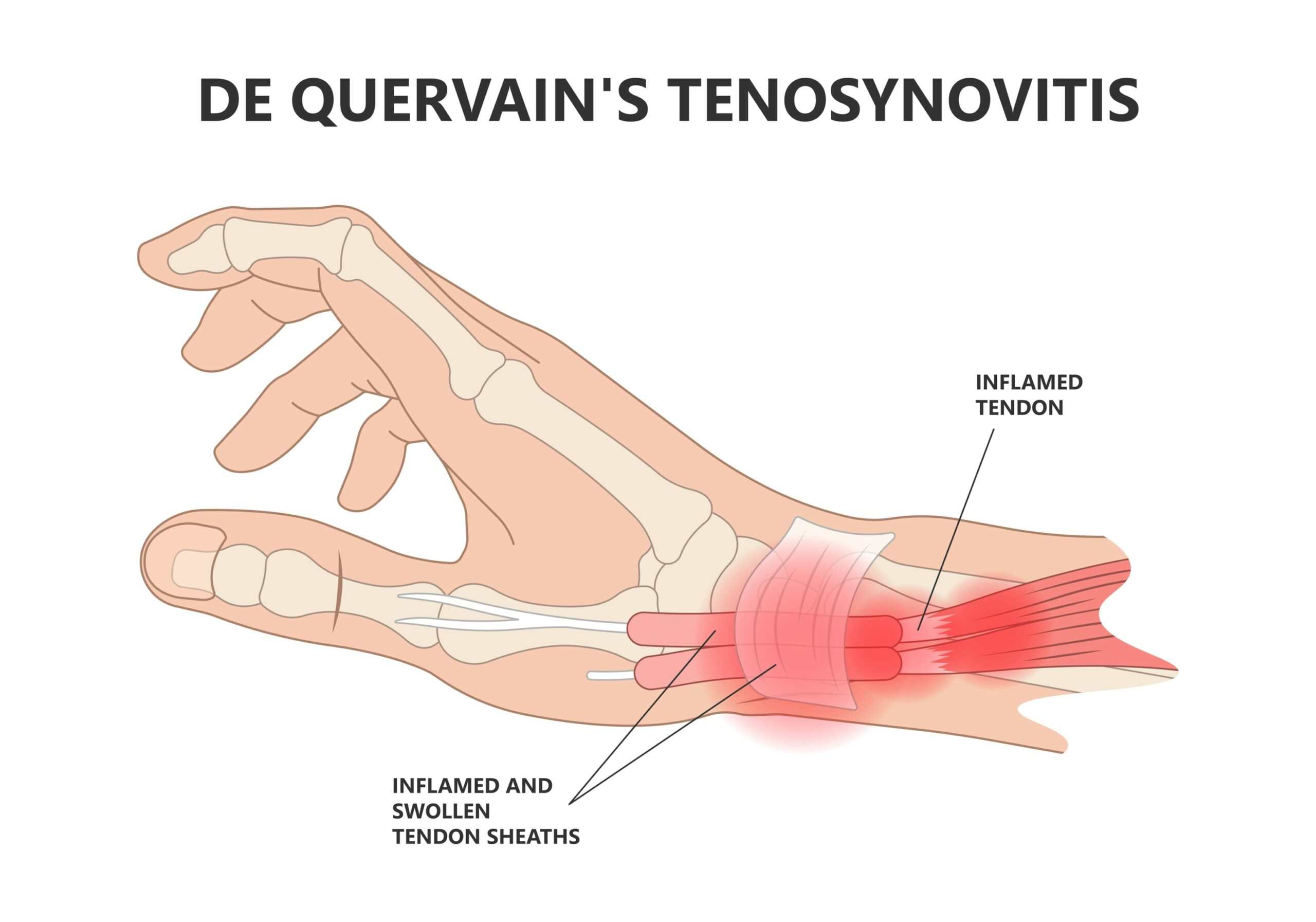De Quervain’s tenosynovitis is a common yet often misunderstood condition that can significantly impact daily activities by causing persistent pain and discomfort on the thumb side of the wrist. This inflammation of the tendons can make even simple tasks like gripping or lifting objects challenging.
In this article, we delve into the root causes, telltale symptoms, diagnostic methods, and available treatment options, offering valuable insights to help you better manage and alleviate wrist pain. Whether you’re experiencing this condition yourself or seeking to understand it for a loved one, this guide provides practical solutions and expert advice for relief.
If you’re struggling with the pain and limitations of De Quervain’s Tenosynovitis, Alliance Orthopedics in New Jersey is here to help. Our dedicated team offers personalized treatment plans tailored to your needs, ranging from lifestyle and ergonomic adjustments to advanced therapies like occupational therapy, splints, shockwave therapy, laser therapy, and precise medical interventions, including injections for severe cases. Don’t let wrist pain hold you back—contact Alliance Orthopedics today to schedule a consultation and take the first step toward relief and recovery.
What is De Quervain’s Tenosynovitis?
 De Quervain is a painful condition that specifically targets the tendons on the thumb side of your wrist. This condition is characterized by swelling and inflammation, leading to significant discomfort and chronic wrist pain. The affected tendons run along the thumb side of the wrist, and when they become inflamed, they can cause severe pain during wrist movements.
De Quervain is a painful condition that specifically targets the tendons on the thumb side of your wrist. This condition is characterized by swelling and inflammation, leading to significant discomfort and chronic wrist pain. The affected tendons run along the thumb side of the wrist, and when they become inflamed, they can cause severe pain during wrist movements.
This condition is quite common and can cause considerable wrist pain that may interfere with daily activities. The pain is often exacerbated by movements that involve repetitive hand or wrist motions, making tasks like lifting, gripping, or even typing quite challenging. The inflammation in the tendon sheath, which encases the thumb tendons, is the primary culprit behind the discomfort experienced in De Quervain’s Tenosynovitis.
Grasping the nature of De Quervain’s Tenosynovitis is crucial for effective management and treatment. Recognizing the symptoms and seeking timely care can prevent pain from worsening and promote faster recovery.
Causes of De Quervain’s Tenosynovitis
The exact cause of De Quervain’s Tenosynovitis isn’t always clear, but chronic overuse of the wrist is often the main culprit. Activities that involve repetitive hand or wrist motions, such as lifting a child into a car seat or carrying heavy grocery bags, are common triggers. These repetitive actions can lead to inflammation in the thumb tendons, causing significant wrist pain and discomfort.
Direct trauma to the thumb or wrist can also provoke the condition. For instance, a sudden impact or injury to the thumb area can trigger the inflammation associated with De Quervain’s Tenosynovitis. Additionally, individuals with rheumatoid arthritis are at a higher risk of developing this condition, as the chronic inflammation associated with arthritis can extend to the tendons.
Other risk factors include new parenthood, frequent gaming (commonly referred to as “gamer’s thumb”), and excessive texting, all of which involve repetitive motions that strain the wrist. Knowing these causes can help you take preventive measures to avoid developing De Quervain’s Tenosynovitis and manage the condition more effectively if it arises.
Recognizing Symptoms of De Quervain’s Tenosynovitis
Early recognition of De Quervain’s Tenosynovitis symptoms can significantly impact condition management. The main symptom is pain at the base of the thumb, which can extend into the forearm when the thumb and wrist are used. This pain is often accompanied by visible swelling near the base of the thumb.
One might also experience a sensation of ‘sticking’ or a feeling of resistance when trying to move the thumb. Untreated, symptoms can worsen, with pain radiating from the thumb into the forearm, complicating simple tasks. The pain can become more intense with wrist motions and may even interfere with your ability to grip objects or perform repetitive hand movements, causing you to feel pain.
Early treatment can prevent symptom escalation. Most individuals see significant improvement within six weeks with prompt care. Noticing these warning signs can prevent De Quervain’s Tenosynovitis from becoming chronic and ensure a faster recovery.
Diagnosing De Quervain’s Tenosynovitis
Diagnosing De Quervain’s Tenosynovitis typically involves a combination of patient-reported symptoms and a thorough physical examination by a healthcare professional. One of the key diagnostic tools used is the Finkelstein test. This test involves bending the thumb across the palm and then covering it with the fingers. The wrist is then bent towards the little finger. If this motion causes pain along the thumb side of the wrist, it indicates a positive Finkelstein test and confirms the presence of De Quervain’s Tenosynovitis.
A positive Finkelstein test strongly indicates the condition, as pain around the thumb signals tendon inflammation. Imaging tests like X-rays are usually not necessary for diagnosing De Quervain’s Tenosynovitis since they do not typically provide additional useful information.
If you experience exacerbated pain when moving your thumb or wrist, and it extends into the thumb and forearm, it’s crucial to consult a healthcare provider for a proper diagnosis. Early diagnosis can prevent the condition from worsening and enable more effective treatment options.
Treatment Options for De Quervain’s Tenosynovitis
Treating De Quervain’s Tenosynovitis primarily aims to reduce pain and decrease swelling. Goals also include reducing inflammation, preserving thumb movement, and preventing recurrence. A healthcare provider can determine how to treat De Quervain’s Tenosynovitis based on symptom severity and duration.
Various treatment options are available, ranging from lifestyle adjustments and ergonomic modifications to occupational therapy, splints, and medical interventions. Recovery time can vary, but with early treatment, symptoms typically improve within 4 to 6 weeks.
Both non-surgical and surgical treatments are effective in managing the condition, depending on individual needs.
Non-Surgical Treatments
Non-surgical treatments are often the first line of defense against De Quervain’s Tenosynovitis. Resting the affected tendons by bracing the thumb and wrist can significantly reduce pain and inflammation. To prevent de quervain’s tenosynovitis, rest is essential for recovery, allowing the tendons to heal without further strain.
Corticosteroid injections are another effective non-surgical option. These injections can provide rapid pain relief, and most patients recover completely after a single injection if treated within six months of symptom onset. Occupational therapy can also be beneficial, helping patients learn new ways to perform tasks that avoid further strain on the wrist and thumb.
Other non-surgical treatments include shockwave therapy and laser therapy, both of which can help reduce pain and promote healing. Combined with lifestyle adjustments and ergonomic changes, these therapies can significantly relieve De Quervain’s Tenosynovitis symptoms.
Surgical Treatments
In more severe cases of De Quervain’s Tenosynovitis, surgery may be necessary. Surgery is typically recommended when symptoms do not improve with non-surgical treatments. The surgical procedure involves making a small incision in the sheath surrounding the swollen tendons to relieve pressure and allow the tendons to move more freely.
Post-surgery, normal hand use is expected, though recovery may involve strengthening exercises and daily routine adjustments. This approach can provide long-term relief and restore full functionality to the affected area.
Lifestyle Adjustments and Home Remedies
Making lifestyle adjustments and using home remedies can play a significant role in managing De Quervain’s Tenosynovitis. Incorporating ergonomic tools, such as wrist supports, can help alleviate stress on the thumb and wrist, reducing the risk of exacerbating the condition. Frequent breaks during repetitive tasks can also minimize strain on the wrist and thumb.
Avoiding repetitive movements and modifying actions to reduce wrist motion stress are key preventive measures against repetitive stress. A therapist can teach new movement patterns and muscle-strengthening techniques, significantly reducing pain and tendon irritation.
Exercises to strengthen wrist and thumb muscles can enhance recovery and prevent future flare-ups. These practical insights can help you manage De Quervain’s Tenosynovitis effectively, relieving pain and preventing further complications.
Seeking Professional Care from Alliance Orthopedics
If persistent wrist pain is disrupting your life, Alliance Orthopedics is here to help. Our expert team, including experienced orthopedists, hand therapists, and occupational therapists, specializes in diagnosing and treating complex wrist and hand conditions like De Quervain’s tenosynovitis.
With eight convenient locations across New Jersey—Fair Lawn, Bloomfield, East Brunswick, Freehold, Randolph, Old Bridge, and Middletown—and a new location in Union, we make it easier than ever to access the care you need. At Alliance Orthopedics, we offer comprehensive treatment options, including ergonomic guidance, occupational therapy, splints, and advanced therapies such as shockwave and laser treatments, tailored to your unique needs.
Don’t let wrist pain hold you back. Contact Alliance Orthopedics today to schedule a consultation and take the first step toward recovery and pain-free living.

